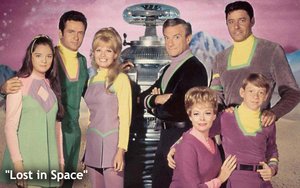 Elevating our old TV shows to something akin to “landmark” status might seem extreme, but the news that Netflix plans
to “reboot” “Lost in Space” has me thinking that extreme measures might be necessary.
Elevating our old TV shows to something akin to “landmark” status might seem extreme, but the news that Netflix plans
to “reboot” “Lost in Space” has me thinking that extreme measures might be necessary.
The company announced this idea earlier this
week. It has ordered 10 episodes of a new “Lost in Space” that will be “reimagined” by a pair of movie screenwriters. Well, if these writers have such great reimaginations,
then why don’t they go and imagine some other idea for a TV show and leave “Lost in Space” alone?
Netflix’s other rebooted series is
“Fuller House,” the updated version of “Full House,” which Netflix is welcome to rework all it wants. But “Lost in Space”? How are you going to reimagine or improve
on that?
advertisement
advertisement
And isn’t “improving” on the old version of a rebooted show really the point? Aren’t these reimagineers really saying
“Just let us get our hands on this thing. We’ll show those ’60s writers and producers a thing or two about making TV shows! Ours will be better!”
The Netflix press release at least had the good manners to include the name of Irwin Allen. He was one of the kings of 1960s television and the producer behind some of the
decade’s more fanciful programs, including “Lost in Space,” “Voyage to the Bottom of the Sea,” “Time Tunnel” and “Land of the Giants.” (Later, he
would become the master of the disaster film with titles such as “The Towering Inferno” and “The Poseidon Adventure.”)
So, Netflix,
you’re going to improve on Irwin Allen? Perhaps where the production technologies available to producers today are concerned, a new space adventure series with the marooned Robinson family
hurtling through outer space and visiting strange planets in high-definition might be considered an improvement on the old show, when taken at face value.
I
get it. A sci-fi space show today stands to look better, in the opinion of some, than a show produced with the technology of the 1960s. But therein lies the appeal of the original “Lost in
Space” -- the way it was rendered using the tools available at the time.
Its settings and sets were extraordinarily fake -- from the
extraterrestrial landscapes strewn with Styrofoam boulders to the plant life that was about as realistic as the plastic flowers that were so commonplace as household décor back then. The
“Lost in Space” prop masters probably bought their outer space plants at Woolworth’s, just like your Aunt Fanny.
In fact, one of the joys
of watching some of the iconic 1960s shows on TV today is to view them in all of their fake finery in high-def. You weren’t meant to see the props and backgrounds in such deep focus, and in such
rich detail, when these shows were first made. When you see them now, they are almost surreal.
Of course, the 1960s ushered in the color-TV era. And shows
such as “Lost in Space” were meant to take advantage of this new vogue in color-TV entertainment. How else can you explain all of those alien beings in colorful fur that you’d see
suddenly leaping out into the open from behind a clump of fake trees to threaten Dr. Smith and the Robot?
For me, the TV shows of the 1960s in particular
possess an allure all their own. I’m sure it’s because of my age since some of the era’s most iconic shows are the first ones I remember watching when I was very young. These include
“Lost in Space,” “Voyage to the Bottom of the Sea,” the original “Batman” and, for reasons I cannot explain, “Sea Hunt.” Go figure.
The people who comb through the archives of old TV searching for concepts to reimagine probably think that TV shows more than 50 years old are ripe for remaking, if not
improving upon.
And it’s true: Millions of people -- particularly the ones they’re trying to reach – were not yet born when “Lost in
Space” and all of its fanciful prime-time brethren held sway on the only three TV networks we had back then. They have no relationship with the original “Lost in Space” except as
some sort of ancient pop-cultural artifact.
I eagerly await this new “Lost in Space,” if only to nitpick about how it will inevitably pale
against the original. You’re going to improve on the original Dr. Smith and his immortal and continuous insulting of the “Lost in Space” robot? You’d have to be a nickel-plated
nincompoop to attempt it.